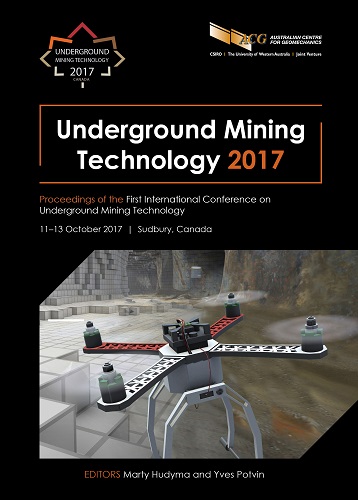Computational fluid dynamic study of primary parallel fan stations

|
Authors: Reyes, G; Hurtado, JP; Vargas, JP; Acuña, EI |
DOI https://doi.org/10.36487/ACG_rep/1710_15_Hurtado
Cite As:
Reyes, G, Hurtado, JP, Vargas, JP & Acuña, EI 2017, 'Computational fluid dynamic study of primary parallel fan stations', in M Hudyma & Y Potvin (eds), UMT 2017: Proceedings of the First International Conference on Underground Mining Technology, Australian Centre for Geomechanics, Perth, pp. 189-202, https://doi.org/10.36487/ACG_rep/1710_15_Hurtado
Abstract:
A computational fluid dynamic (CFD) study was developed considering primary parallel fan stations that are currently in operation within Chilean mines. A set of three station designs were considered, and the CFD modelling was used to simulate the operating points of the fan curves comparing operating performance in terms of airflow pressure and energy consumption. This approach allowed for the identification of the best primary fan configuration based on resistance curve and energy consumption relating to the fan station geometry. To standardise the comparison between the different stations, the same primary fan was used in all the simulations at the same fixed blade angle and speed setting. The simulation implemented the use of threedimensional models, based on two-dimensional prints, considering 7.2 × 7.2 m cross-section headings. Five resistance values were obtained reflecting the fan operating points; one for each geometry, which were then used to identify which model presented the best fan performance. This paper presents the results obtained through the CFD simulations and the corresponding operating points of primary fans. The results are discussed taking into account pressure, velocity and vector contours to understand the fluid dynamics phenomena occurring inside the station. The best-performing station geometry was identified based on the lowest frictional and shock pressure losses, highest airflow delivery and lowest energy cost.
Keywords: parallel fan stations, computational fluid dynamic, underground ventilation design
References:
Acuña, EI, Hurtado, JP & Wallace, KG 2014, ‘A summary of the computational fluid dynamic application to the New Level Mine project of El Teniente’, Proceedings of the 10th International Mine Ventilation Congress, The Mine Ventilation Society of South Africa, Johannesburg, pp 91–97.
Hurtado, JP & Acuña, EI 2015, ‘CFD analysis of 58 Adit main fans parallel installation for the 2015-2019 underground developments of the new level mine project’, Applied Thermal Engineering, vol. 90, pp. 1109–1118.
Isidro, D, Torno, S, Toraño, J, Menendez, M & Gent, M 2010, ‘A practical use of CFD for ventilation of underground works’, Tunnelling and Underground Space Technology, vol. 26, no. 1, pp. 189–200.
McPherson, MJ 2009, Subsurface Ventilation and Environmental Engineering, Chapman & Hall, London.
Versteeg, HK & Malalasekera, W 1995, An introduction to Computational Fluid Dynamics, Longman Scientific & Technical, Essex.
© Copyright 2025, Australian Centre for Geomechanics (ACG), The University of Western Australia. All rights reserved.
View copyright/legal information
Please direct any queries or error reports to repository-acg@uwa.edu.au
View copyright/legal information
Please direct any queries or error reports to repository-acg@uwa.edu.au